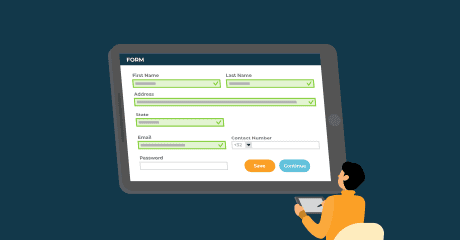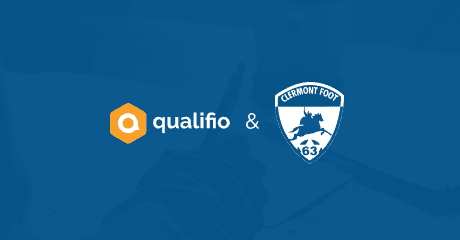Data segmentation in 2025: towards more precision, privacy and personalisation
Brands and companies constantly seek better ways to engage their audiences through data segmentation, data segments and personalisation. These techniques are essential for maintaining strong customer relationships and driving growth.
But don’t you feel things have taken an extremely rapid turn these last few years with advancements in AI, analytics, and stricter regulations?
Let’s be honest: even though it’s sometimes hard to follow, being ahead of the game remains a must for brands. Data segmentation stands at the crossroads of this challenge. It evolved from simple categorisation into a sophisticated strategy driven by precision, privacy, and personalisation.
By 2025, businesses that fail to adapt might fall behind in a world driven by more intelligent use of data and empowered consumers.
In this article, we’ll explore the evolution of data segmentation. From its foundational principles to its role in creating hyper-personalised customer experiences. We’ll discuss the importance of data quality, the transition from data collection to actionable segmentation, and the ultimate goal of personalisation.
Additionally, we’ll highlight real-world examples from leading brands like Pierre Fabre, Unilever, L’Oréal EMEA, and LolaLiza. We’ll showcase how they’ve leveraged segmentation to enhance their marketing strategies.
1. What is data segmentation?
First things first, let’s understand what segmentation is.
Gartner defines segmentation as follows:
Segmentation is a strategic tool for understanding and targeting audiences. It applies an analytical process to categorise customers into mutually exclusive and collectively exhaustive segments that can then be prioritised according to strategic goals. The four most common segmentation approaches include demographic (firmographic for B2B), needs-based, behavioural and value-based segmentation.

While this definition should give you an accurate understanding of segmentation, let’s go further and define data segmentation:
Data segmentation is the process of taking large amounts of data and breaking them down into smaller groups based on specific criteria. It is designed specifically to extract relevant data from a larger data set and make it accessible to users who can, in turn, analyse it for targeted purposes.
You should now better grasp the direction we’re taking here. As data collection methods are getting more and more specialised and varied, data segmentation techniques are also on the rise. Proper data segmentation allows businesses to hyper-focus their marketing strategies and connect with their audiences like never before. Now that consumers demand more relevant and personalised experiences, effective data segmentation isn’t just a competitive advantage; it’s a necessity.
No proper segmentation without data quality
As you can imagine, you first need to collect the data you will use. You need quality data before thinking about data segmentation. Without it, your segmentation will not be qualitative, and your conclusions could be wrong.
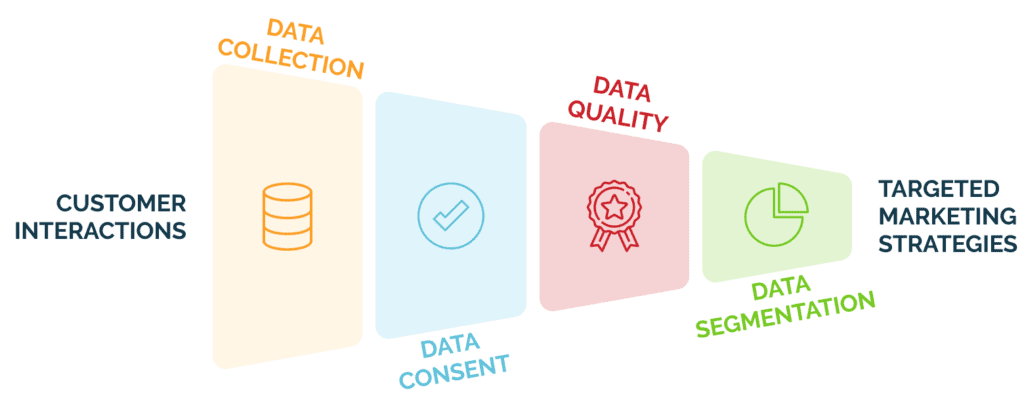
Relying on third-party data is no longer a sustainable strategy, as it has been deprecated. Instead, first-party data (information directly collected from customers through their interactions) and zero-party data (data willingly and proactively shared by customers, such as preferences and intentions) have become critical brand assets. These data types are entirely consented to and transparent, giving them much value nowadays.
Brands can adopt many different strategies to collect these data types, and gamification and interactive marketing have proven very effective. For this matter, data collection platforms, like Qualifio, are now trusted by many brands. These platforms provide the tools to collect high-quality, consented and transparent customer data, which is needed for further data segmentation.
From data collection to data segmentation
The journey from data collection to data segmentation is a crucial, multi-step process that allows businesses to turn raw information into valuable insights. This leads to more personalised and effective interactions with their audience.
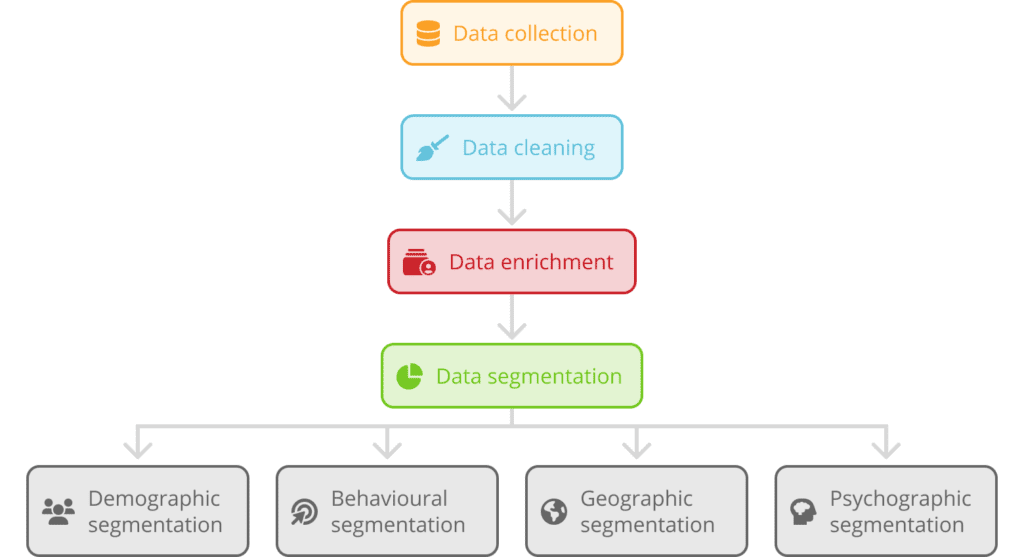
It all begins with data collection, where companies gather raw data from various touchpoints such as websites, mobile apps, social media platforms, customer surveys, and interactive campaigns like quizzes or polls. This data can range from basic demographic information like age, gender, and location to more detailed insights such as browsing behaviour, purchase history, feedback responses, and even preferences explicitly shared by customers.
However, raw data is rarely ready for immediate use. It must first be cleaned and enriched (often with the help of a Customer Data Platform, CDP, for example). Data cleaning involves removing duplicates, correcting errors, and resolving inconsistencies. Data enrichment then adds information and context to fill in gaps. It provides a more complete view of the customer and improving the understanding of their behaviour.
Once the data has been cleaned and enriched, the next step is data segmentation. This process can involve demographic segmentation (age, income, gender) and behavioural segmentation (purchasing habits, product preferences). Brands may also segment data based on geographic or psychographic factors, such as a customer’s lifestyle or values. The more precise the segmentation, the more effectively businesses can target specific customer needs. It improves the relevance of their communication and offerings.
The key to successful segmentation? High quality data: accurate, complete, and relevant.
🎯 Maizena’s contest strategy
Maizena, a Unilever brand, constantly applies this behavioural segmentation. For example, they launched a contest with Qualifio offering participants the chance to win a cooking mixer. To enter, participants shared their identification data and answered segmentation questions about recipes they like to cook and the people they cook for.
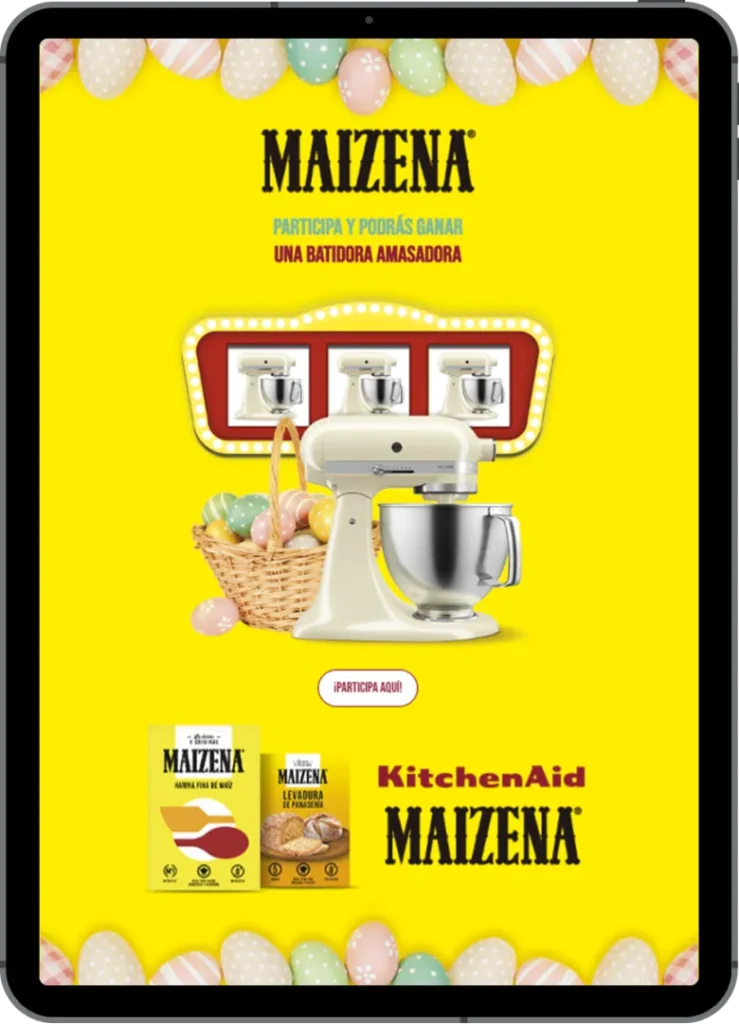
This contest attracted over 52,000 participants who shared their food preferences and cooking tips, consenting to receive promotional communications from Maizena. This enabled Maizena to tailor their product highlights, using data segments, to match the specific interests of each participant.
From data segmentation to customer segmentation
Alright, but where is data segmentation taking us, and why is it so important? The ultimate goal of data segmentation is to make it actionable, and that’s where customer segmentation jumps in. While data segmentation focuses on organising data into groups, customer segmentation takes this further. It groups actual customers into more meaningful categories based on shared behaviours, preferences, and needs.
Businesses can better understand their customers, what they want, and how they behave. This insight enables them to create highly personalised marketing campaigns that speak directly to different customer groups rather than using a single approach. And isn’t this the ultimate goal brands are aiming to reach nowadays?
🌙 LolaLiza: from astrology to data segmentation
LolaLiza’s commitment to personalisation was displayed through the “What is your ideal outfit according to your astro-profile?” campaign, launched alongside the Au Naturel collection.
By leveraging data segmentation, the brand created a unique experience by matching outfits to participants’ astrological profiles.
This strategy involved segmenting customers by astrological sign using their birthdate data, enabling LolaLiza to deliver highly targeted and engaging content. This approach, using data segments, also included personalised email subject lines and content, significantly boosting newsletter open rates.

Additionally, LolaLiza’s A/B testing on Facebook ads, comparing sign-specific content to generic alternatives, highlighted the effectiveness of personalisation in driving customer engagement and optimising marketing strategies.
2. Precision, privacy and personalisation: the ultimate combo
Unlocking hyper-focused insights
The demand for precision in marketing and customer engagement has never been higher. Consumers expect brands to understand their unique needs and preferences and to deliver tailored experiences that resonate with them.
This precision doesn’t just boost engagement; it also ensures more efficient use of resources. Broad and untargeted campaigns do not usually deliver as expected, negatively affecting marketing budgets. Instead, brands can segment their audiences granularly and allocate resources to the most promising segments. This approach increases conversions and maximises return on investment.
Thanks to accurate data segmentation, predictive analytics can take precision to the next level. By analysing historical data and identifying patterns, businesses can forecast future customer behaviours or purchasing decisions. For example, predictive models can reveal which customers are likely to churn, enabling retention efforts, or which segments are most likely to adopt a new product, enhancing marketing efforts.
Privacy: how segmentation guarantees trust and strengthens customer relationships
Data segmentation further ensures that customer data is used only for relevant and specific purposes, reducing the risk of bad use. It allows brands to personalise interactions, focusing on delivering value rather than invading privacy.
To achieve this, brands often leverage advanced platforms like Customer Data Platforms (CDPs). CDPs consolidate and manage customer data for personalisation alongside Data Management Platforms (DMPs), typically used for audience targeting in advertising. These tools enable segmentation while maintaining a structured and ethical approach to data usage.
Additionally, regulations such as GDPR have set strict standards for how customer data is collected, stored, and processed. GDPR ensures that segmentation aligns with legal frameworks. By demonstrating respect for privacy through tailored and non-intrusive communication, brands not only meet regulatory requirements but also deepen trust with their customers. When consumers feel their data is safe and ethically handled, privacy becomes an advantage rather than a challenge.
Personalisation: the climax of data segmentation
Personalisation represents the ultimate goal of effective data segmentation. Today’s consumers expect brands to deliver content, recommendations, and interactions tailored to their unique preferences and needs. Through advanced segmentation techniques, brands can unlock this potential by turning data into actionable insights.
By segmenting audiences based on detailed criteria (ranging from demographic and behavioural data to psychographics and predictive insights), brands can craft hyper-personalised messages and offers. For instance, a fashion retailer might use segmentation to recommend a winter coat to customers in cold regions or suggest eco-friendly options to sustainability-focused shoppers.
💅🏽 Pierre Fabre’s use of data segmentation
A great example is Pierre Fabre, which have successfully implemented data segmentation strategies across their brands and markets.
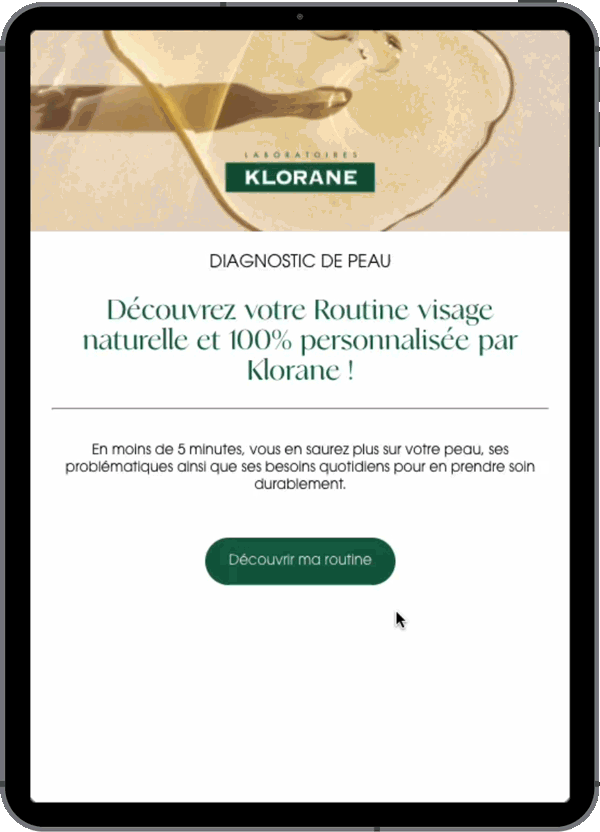
For instance, Klorane use diagnostic tools on its website to guide customers toward solutions for specific beauty concerns. These tools provide tailored results based on customer responses, redirect users to personalised product pages, and send the results via email.
The data collected is pushed in real-time to Salesforce, enriching both new and existing data segments.
Klorane also run engaging campaigns like Advent Calendars, where participants answer segmentation questions, such as their beauty rituals, preferred shopping channels, or hair care needs, and enter a daily prize draw.
Another standout example is Pierre Fabre’s Oral Care brand, which use Qualifio’s wheel of fortune format to collect consumer data.
Promoted via social media, the wheel of fortune engages users with a fun experience while gathering key segmentation data, such as their primary dental concerns (e.g., cavities or plaque).
Users also share additional information through a contact form, including their name, email, and consent, enabling the brand to build detailed customer profiles for tailored communication and offers.
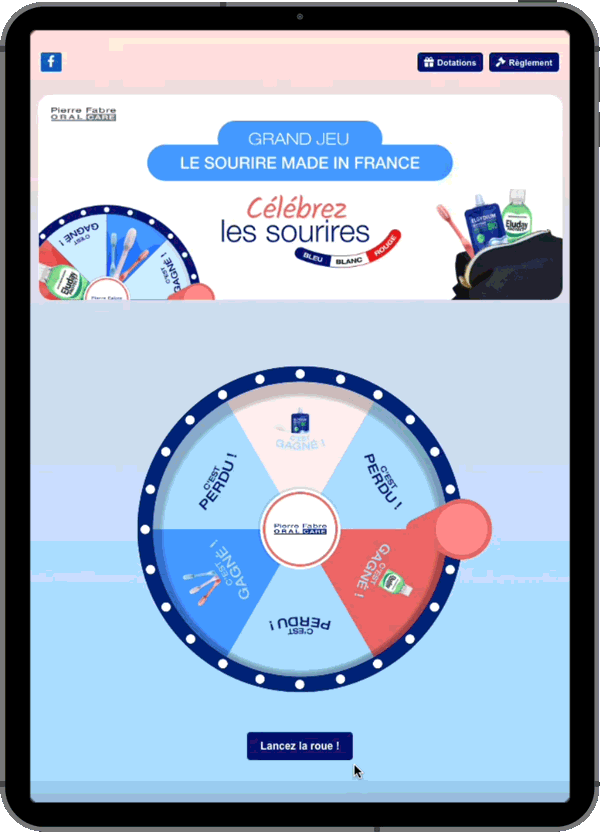
When customers feel understood and valued, they are more likely to engage, convert, and advocate for the brand. Also, personalised marketing based on transparent and ethical data collection and data segmentation ensures the experience feels seamless rather than invasive, the perfect balance between relevance and respect.
🫧 The role of beauty profiles for L’Oréal EMEA
For L’Oréal, creating detailed beauty profiles through data segmentation is pivotal to achieving genuinely personalised marketing. While building an extensive database is essential, the brand recognises that data quality is the key to leveraging this information effectively. Through initiatives like “The Database Requalification Project”, L’Oréal use Qualifio to update and enrich their data to ensure accuracy and relevance.
These beauty profiles, developed using zero-party data collected, such as skin type, hair type, and individual preferences, allow the brand to segment its audience precisely. These profiles considerably help L’Oréal EMEA to deliver tailored product recommendations and marketing messages, ensuring that each customer receives communications that resonate with their unique beauty needs, boosting engagement and loyalty.
In just over a year, L’Oréal EMEA used Qualifio to create 700 campaigns and reach over 5.5 million users. With these campaigns, they are constantly engaging their prospects and customers, which is reflected in the numbers. Just imagine the potential of using proper data segmentation to personalise their campaigns to reach all these users! Personalisation builds emotional connections and brand loyalty.

With Qualifio, we can address two objectives: firstly, to increase the number of contacts we have in our database and, secondly, to work on improving the quality of these contacts. When we launched the data capture program, we were at 0 contacts in our CRM. Today, in Italy, where we started the first pilot program, more than 50% of the contacts come from Qualifio.
Conclusion: data segmentation in 2025 and beyond
Now that we’re entering 2025, data or market segmentation will undoubtedly be a cornerstone of modern marketing, mixing precision, privacy, and personalisation in ways that redefine customer engagement. The rapid evolution of AI, machine learning, and customer data platforms (CDPs) promises to make segmentation even more granular and adaptive, enabling brands to respond to customer needs in real-time. By leveraging high-quality, consented data, businesses can craft meaningful and tailored experiences that resonate deeply with their audiences.
Furthermore, effective data segmentation allows brands to allocate resources strategically, focusing on high-value segments and eliminating wasteful, broad campaigns. This not only improves marketing efficiency but also maximises return on investment. In a landscape where consumers demand relevance and respect for privacy, data segmentation suggests the perfect balance, ensuring trust is maintained while delivering hyper-personalised experiences.
Personalisation, powered by data segmentation, is no longer optional. It’s essential. Brands that embrace the precision of segmentation while prioritising ethical data practices will thrive in 2025’s competitive marketplace. Those who master this balance will stand out and build lasting customer loyalty in a rapidly evolving digital world.
Ready to elevate your data segmentation strategy?
Discover how Qualifio can help you turn data into hyper-personalised experiences!

